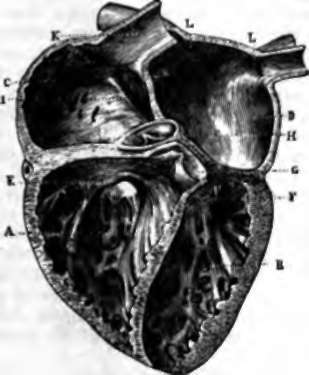Arteries
Description
This section is from the book "Wonders Of The Human Body", by Auguste Le Pileur. Also available from Amazon: Wonders of the Human Body.
Arteries
The vessels which carry the blood from the right ventricle to the lungs, and from the left ventricle to the whole system, are called arteries. The first-named, the ramifications of the pulmonary artery, contain the dark blood which is carried to the lungs to be oxygenized by contact with the air. It is on the contrary red blood which runs in the aorta, the original trunk of all the arteries distributed through the body. There are two classes of arteries, one pertaining to the pulmonary system or lesser circulation, and the other to the aortic or general circulation. We will first consider the last-named.

Fig. 27. Transverse section of the heart.
A. Right ventricle.
B. Left ventricle. C Right auricle.
D. Left auricle.
E. Right auriculo-ventricular orifice and tricuspid valve.
F. Left auricula-ventricular orifice and mitral valve.
G. Origin of the pulmonary artery and sigmoid valves.
H. Origin of the aorta, and valves. I. Orifice of inferior vena cava.
K. Superior vena cava. L, L. Orifice of the pulmonary veins.
The ancient anatomists, finding the arteries empty after death, believed that they were designed to contain air, and from this circumstance they derive their name (aer, air, and terein, to contain). For the same reason, and with more accuracy, they named the tube which conveys the air to the lungs the trachea-artery.
Galen discovered the presence of blood in the arteries, but he retained the name, and others have continued it, although it does not accord with their functions.
The walls of the arteries are composed of three superposed coats. The outer one is fibro-cellular, vascular, and very resistant; the middle one, the membrane proper or elastic, is less resistant, and changes its texture under the influence of age or other causes. The inner is extremely thin, and is analogous in texture to the endocardium. When a ligature is applied to an artery, the internal and middle coats are broken through by the pressure, but the external one resists it.
The arteries communicate with each other in their course through the body, and especially toward the extremities by numerous anastomoses—that is, they join each other either by means of branches, or by forming a net-work, the meshes of which, rounded and in arches, are closer in proportion as the twigs are smaller. They terminate in innumerable microscopic ramifications, called the capillary vessels, which are intermediate between the ends of the arteries and the veins.
The walls of the arteries are nourished, like all other parts of the body, by the vasa vasorum, or vessels of the vessels. And lastly, the arteries are enveloped in their course by numerous nervous filaments from the great sympathetic nerve, and by lymphatic vessels.
The arteries which penetrate the substance of muscles, like those of the thigh and leg, are protected by an aponeurotic sheath, and by fibrous rings which prevent them from being pulled out of place or compressed during the contraction of the muscles which surround them.
Continue to:
